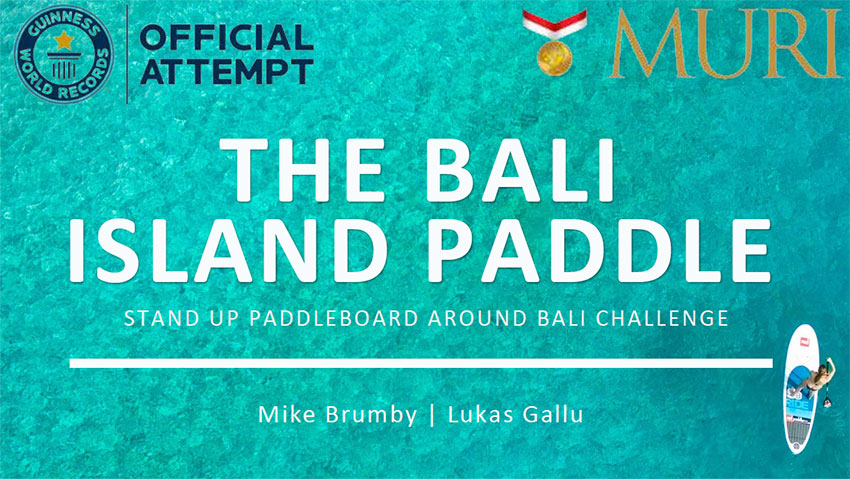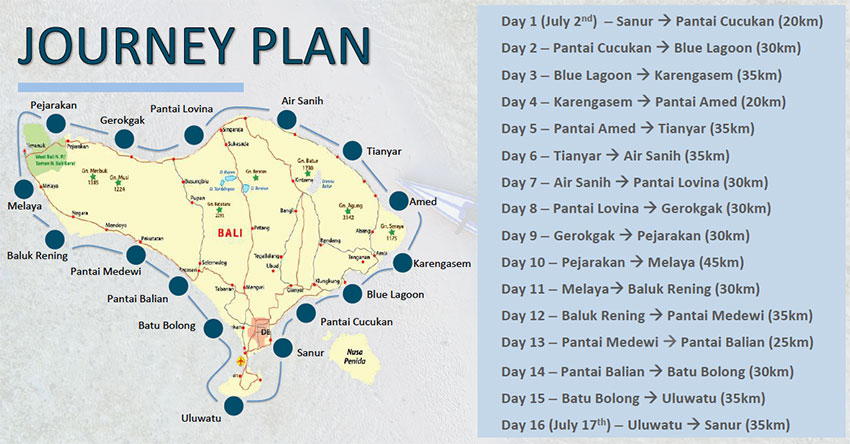Mike and Lukas paddled from Sanur to Tianyar from October 10th to 14th, 2021 to test out their bodies and raise money towards North Bali Reef Conservation. They paddled 150kms in 5 days, 5-6 hours a day and raised around Rp10million. The main thing they gathered from the trip was that the currents and winds are stronger than expected and the challenge to paddle around Bali will be tough and take a lot of preparation.
“Because the oceans are essential to life on Earth”
The ocean is the largest ecosystem on Earth. It is the planet’s life support system. Oceans generate half of the oxygen we breathe and, at any given moment, they contain more than 97% of the world’s water. Oceans provide at least a sixth of the animal protein people eat. Living oceans absorb carbon dioxide from the atmosphere and reduce climate change impacts. The diversity and productivity of the world’s oceans is a vital interest for humankind. Our security, our economy, our very survival all require healthy oceans.
Objectives
- To challenge ourselves to paddle 450 kilometers around the coast of Bali in 16 days.
- To educate Indonesian children about the importance of ocean conservation.
- To raise Rp20million for Coral Triangle Center which focuses on ocean conservation.
“Don’t limit your challenges, challenge your limits” – Tony Robbins
Paddling around Bali will be a very tough challenge. There will be many obstacles to overcome besides the sheer distance of the journey. Many parts of Bali have big waves, strong currents and crossing ships. The heat will also play a big factor. However, Mike and Lukas like to challenge themselves to do things that other people do not think are possible.
No water, no life. No blue, no green” – Sylvia Earle
Corals are important marine animals that form the foundations of a reef. The more corals there are the healthier the reefs are, and the more fish you’ll find in the ocean. Coral Triangle Center wil use the Mars-Assisted Reef Restoration System method that helps to cover barren coral rubble fields and gaps between the remaining live coral on the reef.
This is an interview with one of the initiators Mike Brumby
Tell us about yourself?
I am from the UK and have lived in Indonesia for 31 years. I am an alumni of Jakarta International School. I am currently working as a sports teacher at an international school in Surabaya. In July this year I plan to move back to the UK to be closer to my family. I have many hobbies and one of them is Stand-Up Paddle Boarding.
Explain more about the challenge
The challenge is called, ‘The Bali Island Paddle’. I will be accompanied by my friend Lukas and a team of people on a jukung, a Balinese wooden boat. We will try to paddle around the entire coastline of Bali, which is approximately 450km, using a stand-up paddle board or SUP. It will take us 16 days in total.
Tell us more about SUP
The SUP board is like a surfboard but around 1.5 times bigger. To ride it you need to stand on the board and use a paddle stick. It is generally accepted that SUP originated in Hawaii in the 1940’s. Although still relatively new to Indonesia, SUP has quickly become one of the most popular sports in Indonesia, especially in Bali.
What did you chose to do this challenge?
I chose this challenge because no-one has done this before and I wanted to see if my team could be the first. If we succeed then we will set a Muri Record and, hopefully, a Guinness World Record. However, the main aim is to try to raise awareness for ocean conservation, which is a big problem all over the world, especially in Bali. We need to get the attention of as many people as possible that the oceans needs urgent attention. We cannot keep treating the waterways and oceans like a trash can. We need to try to educate people to understand that human life depends on taking care of our oceans.
What do you hope to achieve from this challenge?
The first hope is that everything goes smoothly and we complete this challenge succesfully. The second hope is that I raise lots of money for the NGO we are supporting whose projects focus on helping the ocean. The NGO is Coral Triangle Center. The third hope is that we can educate more children and their communities about the importance of protecting the ocean. We will do this by stopping at several local schools along our route and talking to students. The final hope is that we inspire others to overcome the obstacles they fear and take risks. I was inspired by Nick Vujicic, a man born without limbs, who said this: ‘Risk, then, is not just part of life. It is life. The place between your comfort zone and your dream is where life takes place. It’s the high-anxiety zone, but it’s also where you discover who you are.’
Can you tell us what the journey will be like?
We will start in Sanur and travel 25-30 km daily. We will go anti-clockwise around the island of Bali. Every day we have a target location that we need to reach. The plan is to reach the target location before noon each day to avoid the hottest part of the day. At each location we will have a hotel set up and a place to park the boat. We will then use the rest of the day to visit a school and rest and recover.
What are the obstacles on the trip?
There will be many obstacles along the way. The first obstacle is, of course, the distance and whether our bodies are able to paddle 5-6 hours each day for 15 days without stopping. One year ago I had major surgery on my back and was told I might never be able to exercise again. The second obstacle we will encounter is environmental conditions, including heat, currents and waves. Some areas in Bali, especially in the south coast area, have strong currents and big waves. We have to be close enough to the shore to avoid the strong currents but at the same time watch out for the waves. To escape the heat we will start paddling before sunrise when it’s still dark. Another major obstacle is crossing the Bali Strait between Bali and Java. We will have to dodge the many large ships crossing there.
Why did you choose the island of Bali?
I chose Bali because it is an island which is very famous all over the world. It’s also an island which has become a spotlight lately for ocean pollution due to too many tourists entering and poor waste management systems. In addition, the island is the perfect size to make the challenge possible but challenging at the same time.
Why do you care about the ocean?
I have spent most of my life being close to the ocean in Indonesia and love water sports – from windsurfing to Scuba Diving. Having healthy oceans is essential for the sustainability of all life on this planet. The more we can do to protect and conserve the oceans, the better.
What is the pollution problem like in Bali and Indonesia?
After China, Indonesia is the world’s second-biggest marine polluter. During the high tourist season, Bali’s famous beaches, such as Kuta and Legian, are buried by up to 60 tonnes of plastic rubbish each day. However, the country aims to reduce ocean plastic waste by 70% by 2025 and to eliminate it by 2040. What we’re doing is only a small part to help but if we can all work together, then perhaps we can accomplish the goal earlier.
How will you publicize the event?
Creating good publicity is an important part of the success of this challenge. Our main point of publicity will be through our Instagram account which is @thebaliislandpaddle. We will also try to collaborate with organizations and Indonesian celebrities who care about marine conservation. Finally, we will go on radio and chat shows to talk about this challenge. We also hope future sponsors can help publicize the event.
What makes you think you can complete this challenge?
First of all my team and I will spend a lot of time planning the trip to avoid any unforseen circumstances. Next we will train hard for this challenge. When I am in Surabaya I will work on my fitnes and when I am in Bali I will spend as much time as possible on the ocean on my SUP to perfect my technique. I’ve taken part in previous challenges that were both mentally and physically demanding so I’m ready for what’s expected. In the past I’ve ridden my bike from Jakarta to Bali, ridden my bike across England and I’ve also flipped a big truck tire around 2 kilometers on Car Free Day in Jakarta. Lukas and I also did a succeesful test run from Sanur to Tianjar, which took us 5 days and over 100km. It was the third of the way around Bali.
What is your training plan in Surabaya?
While in Surabaya, I will not be able to access the sea or use a paddle board. Because of this, I will spend a lot of time swimming or cycling to build my endurance and strength. I will also spend a lot of time working on my balance, flexibility and core strength with yoga. I will also eat more healthily and try to keep my weight lighter than usual.
How will you finance the trip?
We hope to find sponsors who can help fund this challenge. We need to pay for the boat team that will accompany us throughout this trip. We also need to pay for the hotel every night for 4 people. We would also like to have a media crew join us for some segments of the trip. The total expenses will be around 40 million rupiah.
What are the benefits for sponsors?
Every sponsor we get will have a clearly visible logo on the clothes we wear as well as on the paddle boards we use. Their names will be mentioned in all the promotional activities that we do. I think it will be very beneficial sponsors to be involved in this event because is helping to raise money and awareness for a good cause.
Tell me more about the NGO you are supporting
The NGO is called ‘Coral Triangle Center’. They are an organization based in Sanur. Proceeds from the challenge will go towards their marine conservation programs, specifically to support restoration of damaged reefs in Bali through its Adopt-a-Coral program, and to provide environmental education to public school children living in Nusa Penida Marine Protected Area. Donors will receive the following from CTC:
- A Donor acknowledgement e-certificate
- A photo of the baby corals transplanted in its restoration site
- An annual report detailing the growth and progress of the baby corals
- An update about the environmental education program provided to the school children
The target is to raise IDR20million for the NGO.
How can people make a donation?
I have created accounts on gofundme.com and kitabisa.com and people can donate through those accounts. They can be found on our Instagram account.



